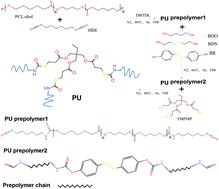当前位置:
X-MOL 学术
›
Soft Matter
›
论文详情
Our official English website, www.x-mol.net, welcomes your
feedback! (Note: you will need to create a separate account there.)
Analysis of the microphase structure and performance of self-healing polyurethanes containing dynamic disulfide bonds.
Soft Matter ( IF 2.9 ) Pub Date : 2020-08-31 , DOI: 10.1039/d0sm01072c Qiqi Qu 1 , Hua Wang 2 , Jing He 1 , Tengfei Qin 1 , Yunsheng Da 1 , Xingyou Tian 3
Soft Matter ( IF 2.9 ) Pub Date : 2020-08-31 , DOI: 10.1039/d0sm01072c Qiqi Qu 1 , Hua Wang 2 , Jing He 1 , Tengfei Qin 1 , Yunsheng Da 1 , Xingyou Tian 3
Affiliation

|
Self-healable polyurethanes can be used in various fields for extended service life and reduced maintenance costs. It is generally believed that the shape memory effect is helpful for achieving a high healing efficiency. The morphological features were focused on in this study as microphase separation is one of the main factors affecting various performances of polyurethanes, including their shape memory behavior and mechanical properties. Microphase separation can be regulated by changing the content and types of the hard segments. With this in mind, polyurethanes from polycaprolactone diol, hexamethylene diisocyanate, and different chain extenders were synthesized, characterized, and designed as promising self-healing polymers. All the polyurethane specimens were equipped with a similar content of hard segments but diverse types, such as aliphatic, aromatic, and disulfide-bonded. Differential scanning calorimetry, thermogravimetric analysis, X-ray diffractometry, infrared spectroscopy, and atomic force microscopy were used to describe the microstructures of the polyurethanes, including the crystalline regions. The relationship between the microphase separation structures and material properties was focused on in this examination. Various properties, including the thermal stability, mechanical behavior, hydrophobicity, and self-healing efficiency showed significant differences due to the change in the hard segments’ structure and multiphase distribution. The aliphatic disulfide stimulated the conformation of a proper microphase separation structure (the large heterogeneous structure at physical length scales as well as a more sufficient combination of soft and hard phases), which helped to improve the healing effect as much as possible by effective wound closure and the exchange reactions of disulfide bonds.
中文翻译:

含动态二硫键自修复聚氨酯的微相结构与性能分析
自修复聚氨酯可用于各个领域,延长使用寿命并降低维护成本。人们普遍认为形状记忆效应有助于实现较高的治愈效率。本研究重点关注形态特征,因为微相分离是影响聚氨酯各种性能(包括形状记忆行为和机械性能)的主要因素之一。微相分离可以通过改变硬链段的含量和类型来调节。考虑到这一点,由聚己内酯二醇、六亚甲基二异氰酸酯和不同扩链剂制成的聚氨酯被合成、表征和设计为有前途的自修复聚合物。所有聚氨酯样品都具有相似含量的硬链段,但类型不同,例如脂肪族、芳香族和二硫键。使用差示扫描量热法、热重分析、X射线衍射法、红外光谱法和原子力显微镜来描述聚氨酯的微观结构,包括结晶区域。本次研究的重点是微相分离结构与材料性能之间的关系。由于硬链段结构和多相分布的变化,包括热稳定性、机械行为、疏水性和自修复效率在内的各种性能表现出显着差异。 脂肪族二硫化物刺激了适当的微相分离结构的构象(物理长度尺度上的大的异质结构以及软硬相的更充分的结合),这有助于通过有效的伤口闭合来尽可能提高愈合效果以及二硫键的交换反应。
更新日期:2020-10-15
中文翻译:

含动态二硫键自修复聚氨酯的微相结构与性能分析
自修复聚氨酯可用于各个领域,延长使用寿命并降低维护成本。人们普遍认为形状记忆效应有助于实现较高的治愈效率。本研究重点关注形态特征,因为微相分离是影响聚氨酯各种性能(包括形状记忆行为和机械性能)的主要因素之一。微相分离可以通过改变硬链段的含量和类型来调节。考虑到这一点,由聚己内酯二醇、六亚甲基二异氰酸酯和不同扩链剂制成的聚氨酯被合成、表征和设计为有前途的自修复聚合物。所有聚氨酯样品都具有相似含量的硬链段,但类型不同,例如脂肪族、芳香族和二硫键。使用差示扫描量热法、热重分析、X射线衍射法、红外光谱法和原子力显微镜来描述聚氨酯的微观结构,包括结晶区域。本次研究的重点是微相分离结构与材料性能之间的关系。由于硬链段结构和多相分布的变化,包括热稳定性、机械行为、疏水性和自修复效率在内的各种性能表现出显着差异。 脂肪族二硫化物刺激了适当的微相分离结构的构象(物理长度尺度上的大的异质结构以及软硬相的更充分的结合),这有助于通过有效的伤口闭合来尽可能提高愈合效果以及二硫键的交换反应。









































 京公网安备 11010802027423号
京公网安备 11010802027423号